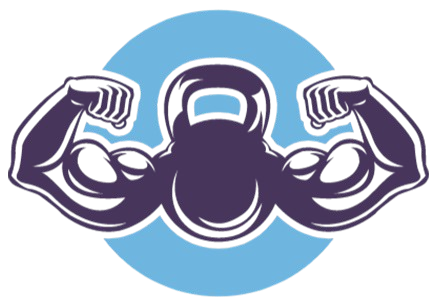Fitpro Income
What Does A Fitness Instructor Do? (Complete Breakdown)
If you’re considering becoming a fitness instructor, you probably want to know what you’ll be doing all day, right?
Well, fortunately, I have been one (twice actually), so I can give you a good idea of what it’s like to be a fitness instructor.
In this article, I will be going through each of the responsibilities you will have and explaining what they actually mean whilst fully answering the question “what does a fitness instructor do?”.
I’m literally telling you what my days used to be like, so you really can’t get a more accurate account than this.
Sound good?
Let’s go…
Fitness Instructor roles and responsibilities
- Taking gym members through induction sessions
- Writing session programs
- Teaching gym floor or studio-based classes
- Cleaning/tidying the gym
- Some front of house/reception cover
- Equipment safety checks
- Opening and closing the gym
- Answer member questions about equipment and training
- Establish rapport with members to increase retention
- Report any accidents and provide first aid to members
- Schedule and organise member re-programming
- Giving gym floor orientations to prospects
The list above is everything that I used to do, not necessarily daily, but on a fairly regular basis.
I don’t want this article to be too huge, so I will briefly outline what each of these tasks entails so you can get a pretty good idea of what a fitness instructor or gym instructor actually does in their role.
I hope this breakdown fully answers your question.
Taking gym members through induction sessions
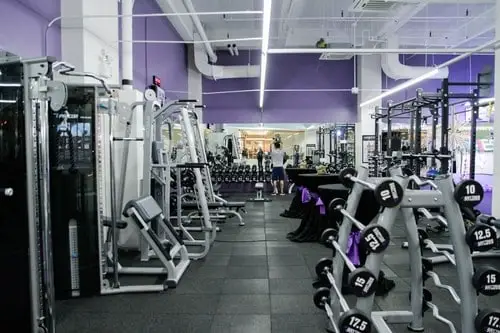
New members need to be walked through the full range of equipment you have and shown how to use them correctly.
You will show them the cardiovascular and weights machines, and how to use them safely. Usually, you will demonstrate first, and then have them show you that they can use the machine correctly on their own.
You won’t usually need to show brand new members the free-weight areas and associated exercises, as there are almost unlimited possibilities, but you might walk them through the area to show them what’s available as part of the general gym floor walkthrough that you will complete.
As you are giving the new member a walkthrough, you should also highlight points of interest like safety exits, water fountain points, etc, however, most of the time these will have already been covered by the salespersons’ gym tour.
Writing session programs
This is where you get to be a little more creative and put what you’ve learned in your level 2 course into action.
For a great insight into how hard it is to pass the level 2 fitness instructor, have a read of the super detailed article I wrote about it by clicking the link below.
How hard is the Level 2 Fitness Instructor course?
After talking to a new member and finding out their goals and whether or not they have any injuries, you will write out a simple exercise routine for them to use that will help them attain their goals.
You will usually be prescribing fairly simple exercises, so it’s usually best to recommend they use machines over free-weights, as you will also only have a short amount of time to demonstrate the exercises to them after you have written it out for them.
Teaching gym floor or studio-based classes
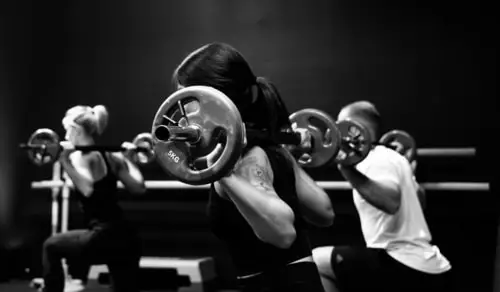
I loved this bit, which always surprises my friends because I’m a pretty introverted person, but teaching gym floor and studio classes were really good fun for me.
As a fitness instructor, you will be asked to take either gym floor classes, studio classes, or both. Gym floor classes are usually 20 mins to half an hour, and studio classes can be up to 45 minutes long.
It’s more likely that if you don’t have any exercise to music qualifications, you will only be asked to teach gym floor classes, but in my time as an instructor, I was asked to teach plenty of 45-minute studio classes, so it can happen.
Gym floor classes are pretty simple, usually things like HIIT classes, kettlebell classes, abs workshops, or pre-made classes created by the company themselves.
If they are basic classes like abs or kettlebell demonstrations, you will usually make the class up yourself, whereas if they are created by your employer, you may go on a course to learn how to teach them correctly.
They are pretty easy, and pretty good fun to teach.
Teaching gym floor classes also features in one of my articles as one of the top ways to pick up personal training clients, so if you’re looking to become a personal trainer, have a read of the article below to see just how easy teaching great gym floor classes can make picking up new clients.
Selling Personal Training in a gym: What you need to know
Cleaning/tidying the gym
Ah, everybody’s favorite part of being a fitness instructor, cleaning the gym floor.
It’s actually not that bad really, but the reality is that you will be cleaning the equipment down with a spray and cloth after the busy periods have come and gone (usually around 9am for morning shifts and 3pm for afternoon shifts).
The machines need to be kept clean of people’s sweat (I know it’s gross) otherwise the equipment can quickly become unsanitary and people can develop rashes etc.
I used to split the work with another colleague, so one day I would take the cardio equipment such as the treadmills and bikes and they would clean all the machines, then we would swap the next day.
It doesn’t take that long and It’s really not that bad.
Some front of house/reception cover

This might not be the same for everybody, but seeing as I am listing everything that I used to do, I’ve put it on this list.
Every now and then, usually at the opening and closing times of the gym, I would have to do a small amount of “front of house” or reception work as most would call it.
It was usually just taking payments for protein shakes and people paying for lockers etc, nothing too complicated usually, but I did receive some basic reception training so that I knew what I was doing.
This hasn’t been the case in all gyms I’ve worked in, some had reception teams that were staffed from opening to close each day, but I did it, so it’s on this list because perhaps you might need to do it at some point too.
Equipment safety checks
It’s really important that all the machines and equipment are kept safe for the members to use at all times.
Every few weeks you will need to check each piece of equipment for any damage or general wear and tear so that it can be reported to be fixed.
You’ll be looking for things like frayed cables on machines, leather padding becoming damaged or any loose nuts/bolts, etc.
It’s pretty easy to do, you’ll be given a sheet with all the equipment that needs to be checked and you just tick it off as you go and report any problems back to your manager.
Opening and closing the gym

A big responsibility of a fitness instructor is opening and closing the gym, again, in your gym, there may be staff that will do this for you, but as I’ve said, I did it so it’s on the list.
If you are opening and closing the gym, you will either be given a set of keys, passcodes, or both. You will be trusted to get to the gym with plenty of time in the morning for you to be able to open the gym, turn on all the machines, and generally prep the gym for opening.
When closing, I needed to make sure all cash from the reception till was counted correctly and put into the system correctly, ensure all rooms of the gym were empty of all members, equipment was turned off and the gym was locked correctly.
I’ll be honest, I had sleepless nights when It was my turn to close because I thought I hadn’t locked up properly, but after doing this a few times, it really stops being an issue.
Answer member questions about equipment and training
Not every member will opt for an induction session or to have a program written up for them when they join.
Later into their training, they might start to have questions about different pieces of equipment or questions about training in general. They will come to you for answers to these questions, so be ready for them.
That’s not actually as intimidating as I have made it sound, because if there is a question you are asked, there is nothing wrong with saying you are unsure, going away, and coming back with an answer on either the same or next day.
Generally, most of the questions you will be asked will be pretty simple (for you at least), so you should be able to answer them pretty easily.
It’s actually really nice to be able to help out people by answering their questions, and if you can answer them clearly, they will keep coming back to you for advice, and let’s face it, that’s basically the main point of your job, so take it as a compliment if it happens.
Establish rapport with members to increase retention
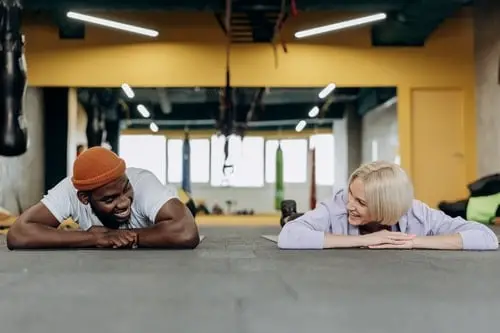
If people aren’t spoken to and helped out in a gym, they often give up and quit, it’s just the way it is.
Most of the time, people are only getting one or two things wrong with the training that’s holding them back from making great progress, but it could just be the fact that they don’t feel engaged with or connected to their gym in any way which discourages them.
The easiest way for a gym to keep up member retention (stop its members from leaving), is to make sure the fitness team is interacting with and building rapport with its members. As part of the fitness team, it’ll be up to you to go around and chat with them and basically make friends. This doesn’t sound difficult, but you’d be surprised at just how important this aspect of fitness instruction is.
It’s not to say that you are going to be best mates with all the members, but sometimes just having someone come up to them and see how they are can make a member really feel like the gym they belong to cares about them, which makes them more likely to stay.
I always enjoyed this as it was an excuse to just go and chat with people. It doesn’t even have to always be about fitness, you can just go up to someone whilst they are on an exercise bike and see how their day is going. They will probably be relieved to hear someone wants to know how they are doing without trying to then sell them something.
Report any accidents and provide first aid to members

Most gyms will put you on a first-aid at-work course almost as soon as they employ you if you don’t already have your certificate.
This is because as a fitness instructor you will be one of the first points of contact should an accident occur in the gym. Most companies will make sure nearly everyone that is working in the building is first aid qualified, but fitness instructors are usually in the heat of the action and the first responders to accidents.
You will still only be helping with very basic first aid, so there’s no need to panic. I think the most severe thing I had to help out with was a member who had a seizure whilst on a treadmill, he was fine, and we really just had to make sure he wouldn’t hurt himself whilst he was having it.
Obviously, your experience could be different, and you could face something more serious, but that’s exactly why you will be trained up.
But, you’ll mostly be dealing with cuts and cruises, maybe a bump to the head or two, I really wouldn’t let this put you off at all.
Schedule and organise member re-programming
When you design and give a new member their exercise program card, they will usually be set for about 5-6 weeks. After that point, you will need to ask them to come back to you, discuss how they have been getting on with the program you gave, and answer any questions they have about it.
Once you’ve had your little sit-down, you will need to write them out another program to make sure they are progressing. This is usually your opportunity to advance the workout a little (if that’s what the member wants) as they may be starting to get a little bored of the more basic exercises.
Designing great programs is a really important part of member retention, if you give people fun workouts they will keep coming back to the gym.
It’s pretty good fun to see people enjoying the workouts you are prescribing, and if you are looking to get into personal training as your next step in your fitness career, making sure you are designing great programs is very important, so it’s a great way to practice.
Giving gym floor orientations to prospects
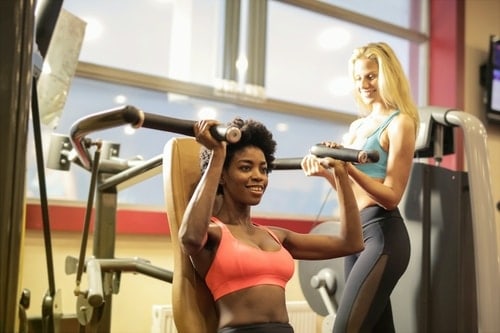
This task is super easy, sometimes the sales team will have multiple people come into the gym at the same time that wants to be shown around to see if they will join.
If they don’t have time to show everyone around, they might ask you to give a quick few tours, after all, you are the person who understands the layout of the gym more than pretty much all the other employees.
You won’t have to do much “selling” when you are giving the tours, that’s where the salespeople come in, but once you get a little more confidence, there is no harm in talking to the salespeople to see if there are certain questions you can answer or even ask to help the salespeople out whilst you are giving the tours. It’s good practice if you are thinking of taking this route in your career.
Conclusion
So there you go, this is everything that I used to do whilst I was working as a fitness instructor, and I did it for around 2.5 years in total, so this article should answer the question “what does a fitness instructor do?”, pretty well.
It’s a really fun role, and nothing that you will be doing is too stressful or difficult and there are tons of career progressions you can take.
As you can see, there isn’t one main task that a gym instructor does, your role will be spread out between lots of different tasks each and every day, which really helps keep the job interesting.
These are just some of the more standard things you can do, but if you’d like to see how you can take things a step further take a look at the article I wrote below that clearly explains how you can go the extra mile and be one of the best fitness instructors out there.
8 Easy Ways To Go The Extra Mile As A Fitness Instructor
Or if you’re still considering whether or not you should look into being a fitness instructor as a career, how about taking a look at this article, that explains the reality of being one? It should help you make your decision a little easier.
What’s It Like Being A Fitness Instructor? The Truth!
Hopefully, this article has fully answered your question, and if you decide to come into the world of fitness I wish you the very best of luck!
Go get ’em!
